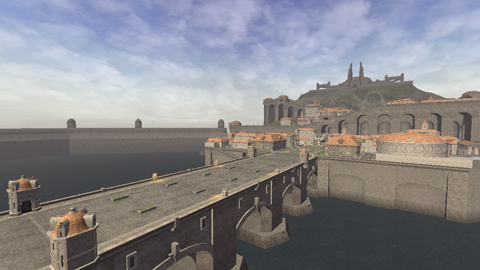Adoulin is a storied land, with a history intriguing enough to rival those of the Middle Lands and Aht Urhgan.
Under what circumstances did the Sacred City of Adoulin come to be? What is life like in this mysterious nation?

History
Adoulin is the name given not just to the city on the main island, but to the outlying island chain as well.
About 200 years ago, the age of pioneering that dominated the political scene?an age referred to by historians as "the great expedition"?drew to a close.
The plans for colonizing Ulbuka were postponed indefinitely, and a large wall known as Jorius Yett was constructed between Eastern Ulbuka and Adoulin proper?a task which took many years and thousands of workers to accomplish. This massive structure enclosed what little was left of habitable land in Adoulin and its dwindled population.
The great expedition came to an end after hundreds of years. Yet the wounds left by this retreat were severe, as merchants, nobility, and even common folk sunk nearly all their resources into expanding Adoulin's domain within Ulbuka. The resulting economic collapse closed the curtain on what would have been a shining future for the budding nation.
The ruling house of Adoulin and the eleven noble orders, sensing the need for change if Adoulin was to survive, elected to dissolve the long-standing imperial system, rearranging the government into what was to become known as the Sacred City of Adoulin.
The first goals the empire set its sights on were not to simply recover from its martial decay, but also to contain the surrounding island nations. These considerations bore fruit, as Adoulin developed into a city-state with well-funded mercantile trade.
In recent years, Ygnas S. Adoulin, leader of the Order of Adoulin, declared that the colonization project was to be restarted after countless centuries. This move was not without political consequences, however, and the alliance between the twelve orders has started to fracture into factions supporting and opposing the project.

| Illustration: Mitsuhiro Arita |
Adoulin's Establishment
In ancient times, the Isle of Adoulin and other surrounding islands were ruled by a fierce crocodile-like demihuman race known as the Velkk. The great hero August, a man called "the founder king" and whose legacy is felt in Adoulin to this day, drove them out from Adoulin, with what little forces they had remaining seeking refuge in the far western part of Eastern Ulbuka. August constructed a castle on the land the Velkk once held, and a city sprung up in the surrounding area. This was the origin of the Adoulinian Empire. In recognition of their great service to the first king, eleven of August's most trusted soldiers were granted land and status, and formed the other eleven orders of Adoulin that exist to this day.
Politics and Government
Adoulin is governed by a ruling council that makes decisions via consensus. The grand chancellor is Ygnas S. Adoulin, but as the council has the final say over all matters both domestic and international, the position is merely an honorary title.
|
Grand Chancellor Ygnas S. Adoulin
|
|||
|
Minister of Finance Melvien de Malecroix
|
|||
|
Minister of Justice Hildebert
|
|||
|
Minister of Public Affairs Svenja
|
|||
|
Minister of Education Ikhi Askamot
|
|||
|
Minister of Commerce Chero-Machero
|
|||
|
Scouts' Coalition Maester Margret
|
|||
|
Pioneers' Coalition Maester Lhe Lhangavo
|
|||
|
Peacekeepers' Coalition Maester Gratzigg
|
|||
|
Mummers' Coalition Maester Flaviria
|
|||
|
Couriers' Coalition Maester Reginald
|
|||
|
Inventors' Coalition Maester Amchuchu
|
Population
Humes: 35%
Mithra: 25%
Elvaan: 15%
San d'Orian Elvaans: 10%
Ouschrahd Galka: 10%
Other: 5%
Language
Common
Major Religions
Eimert Church (believers in Altana)
Church of San d'Oria (believers in Altana)
Island Animitism
Talekeeperism
Tavnazian (believers in Altana)
Major Landmarks
Castle Adoulin
Exorcists' Priory
The Silver Spoon (members-only auction house)
Celennia Wexworth Memorial Library
Fontis Xanira
Jorius Yett
Platea Triumphus
Statue of the Goddess
Mog Gardens
